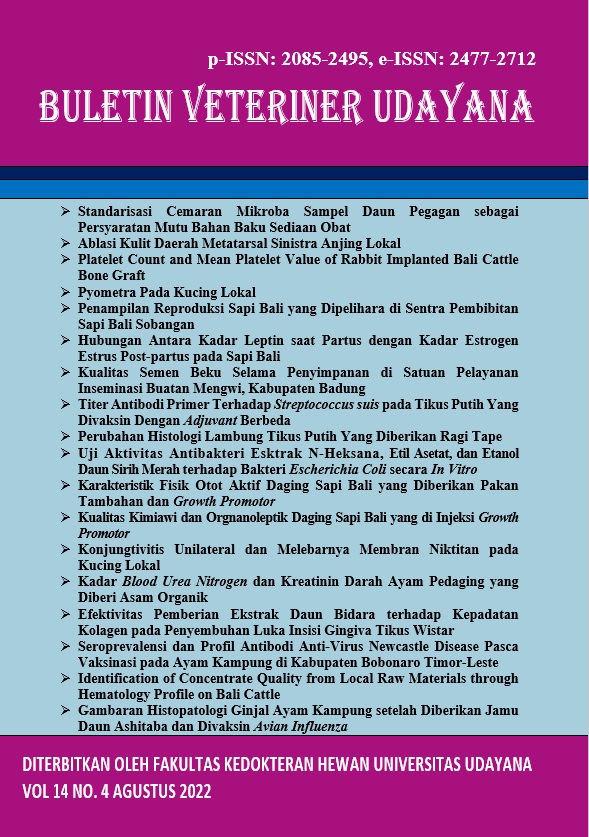DESCRIPTION OF NATIVE CHICKEN HISTOPATHOLOGY AFTER GIVEN ASHITABA LEAF EXTRACT AND AVIAN INFLUENZA VACCINE
Abstract
This study aims to determine the effect of giving the herb ashitaba leaf (Angelica keiskei) which is given orally, and with varying doses on the histopological picture of the native chicken kidneys. The sample used in this study were 25 Day Old Chicken (DOC) native chickens, which were divided into 5 groups. The first treatment was (P0) without being given ashitaba leaf herbal medicine but given aquadest, group (P1) was given ashitaba leaf herbal with a concentration of 50mg / head / day, (P2) at a dose of 100mg / head / day, group (P3) with a dose of 200mg / head / day, and (P4) at a dose of 400mg / head / day. The treatment is carried out every day for 14 days from day 8 to day 21 which is given orally by mixing drinking water and ashitaba leaf herbal powder until the volume is 100 ml. On day 21, all groups of chickens were vaccinated with the Avian influenza vaccine. On the 42nd day, the experimental native chicken was dinecropsed, then the kidneys were taken to see the changes in the histopathological structure and read the preparations, for the results of the data obtained, the Kruskal-Wallis non-parametric statistical test was performed. Based on the results of the research that has been done, it can be concluded that giving the herbal ashitaba leaf with a range of doses 50mg / head / day up to a dose of 400mg / head / day for 14 days no significant effect on the histopathological picture of native chicken kidneys vaccinated with Avian influenza as seen from congestion and necrosis.
Downloads
References
Baba K, Taniguchi M, Shibano M, Minami H. 2009. The components and line breeding of angelica keiskei koidzumi. J. Bunseki Kagaku. 58(12).
Jaya IGNIP, Leliqia NPE, Widjaja INK. 2008. Uji aktivitaspenangkapan radikal DPPH ekstrakproduk teh hitam (Camelia sintensis(L.) O.K.) dan gambir (Uncaria gambir(Hunter) Roxb) serta profil KLT-Densiometernya. J. Farmasi Udayana. 1(1): 86-101.
Kestaria, Nur H, Malik B. 2016. Pengaruh substitusi pakan komersil dengan tepung ampas kelapa terhadap performa ayam kampung. J. Peternakan Nusantara. 2(1): 2442-2542.
Li L, Aldini M, Carini CYO, Chen H, Chun S, Choo K, Park CR, Correa RM, Russell JB, Blumberg, Yeum K. 2009. Characterisation, extraction effieciency, stability and antioxi dant activity of phytonutrients in Angelica kesikei. Food Chem. 115: 227-232.
Nurcholis, Dewi H, Barep S. 2009. Tatalaksana pemeliharaan ayam ras petelur periode layer di populer farm desa kuncen kecamatan mijen Kota Semarang. Mediagro. 5(2): 38-49.
Prakash A. 2001, Antioxidant Activity. Medallion Laboratories Analytical Progress. 19:2.
Sembiring BB, Manoi F. 2011. Identifikasi mutu tanaman ashitaba. Bul. Littro. 22(2): 177-185.
Sudiono J, Budi K, Andhy H, Bing D, 2003. Ilmu Patologi. Jakarta.





